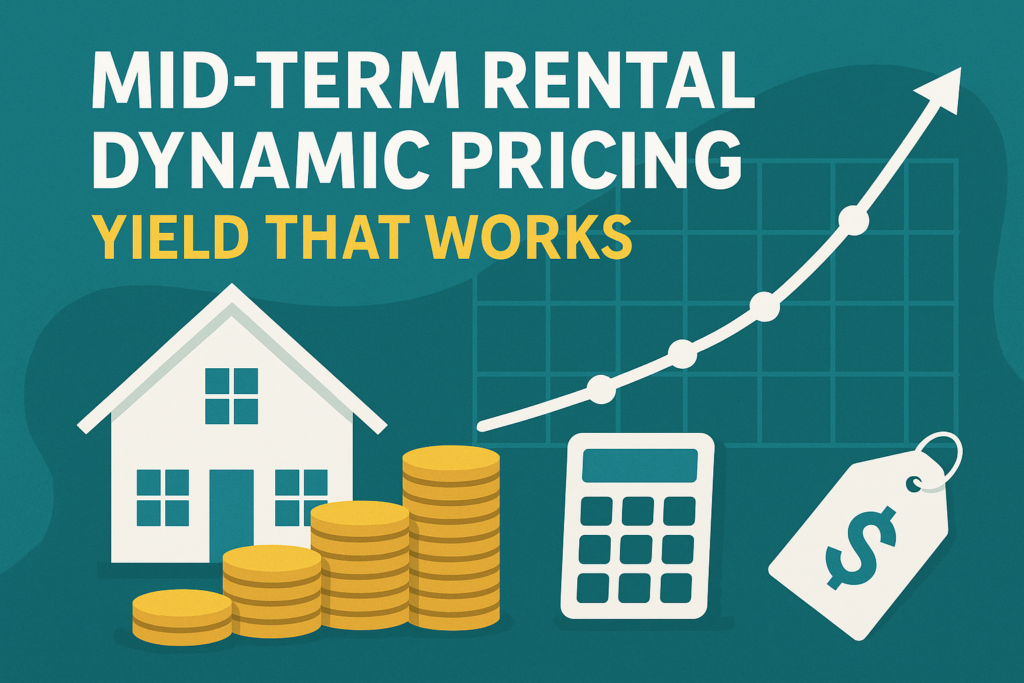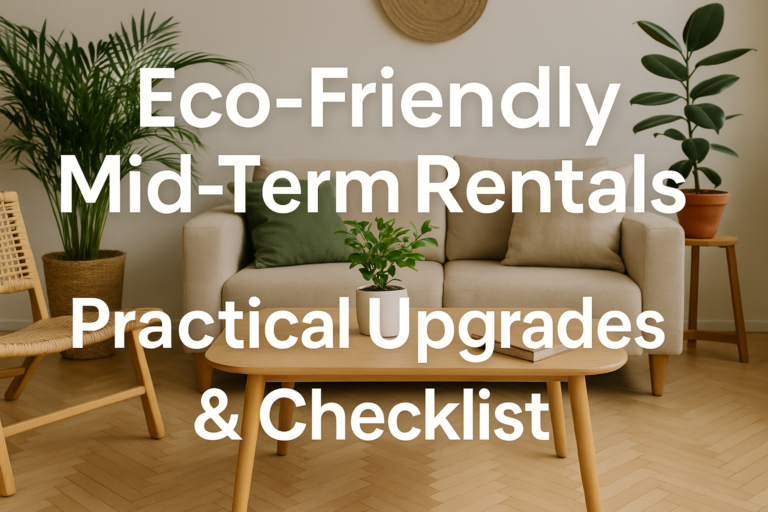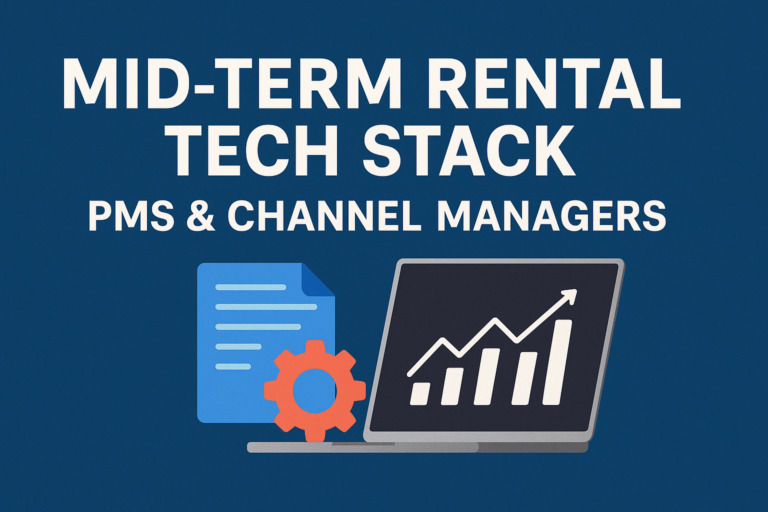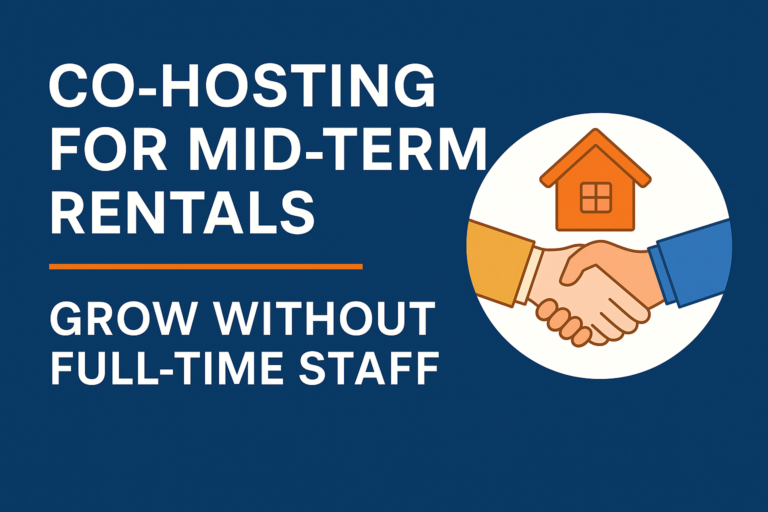Intro — why mid-term rental dynamic pricing matters
Mid-term stays (30–180 days) sit between nightly bookings and long leases. That means your pricing needs to balance occupancy, furniture & utilities, and lower turnover costs. Good mid-term rental dynamic pricing raises revenue without increasing vacancy. This post gives a practical, repeatable approach you can test this month.
This article plugs directly into the Mid-Term Rentals Optimization Playbook — Boost Revenue: treat dynamic pricing as one of the core levers the playbook recommends for steady, predictable income.
The goal of mid-term rental dynamic pricing
You want two things at once: steady occupancy and steady net income (NOI). With longer stays you get fewer turnovers, lower per-day servicing costs, and higher guest quality — but you also must justify a monthly price that’s attractive versus nightly platforms and long-term leases. Dynamic pricing for mid-term rentals finds that sweet spot, and then adjusts for season, extensions, and vacancy risk.
Data you need (fast)
Collect these before you change a price:
- Local comps: monthlies on MiniStays, Airbnb (28+ filter), Zillow furnished rentals.
- Your historical data: occupancy, length of stay distribution, turnover cost per booking.
- Seasonality calendar: local events, snowbird windows, school terms.
- Costs: mortgage/lease, utilities, cleaning per turnover, platform fees, furnishing depreciation.
- Demand signals: number of leads, conversion rate, days to rebook.
If you don’t have a PMS, a simple Google Sheet with last 12 months of bookings will do.
Build a simple mid-term pricing model (practical formula)
Start with a baseline monthly number, then adjust.
Step A — baseline monthly equivalent:
- Multiply your market short-term nightly rate by 30 to get a “monthly equivalent.”
Example: $120/night → $120 × 30 = $3,600.
Step B — target mid-term % (typical range 60–80% of monthly nightly equivalent):
- Use a conservative starting point: 70% of the monthly equivalent.
From the example above: 70% × $3,600 = $2,520.
Step C — factor vacancy buffer (10–15%) and costs:
- If you assume 10% vacancy, your effective target becomes 90% of step B: $2,268.
Step D — set extension discounts:
- 60+ days: test a 5–8% discount (example 7% → $2,343.60).
- 90+ days: test a 8–12% discount (example 10% → $2,268.00).
(Those example numbers come from the step-by-step model above: monthly equivalent $3,600 → mid-term target $2,520 → 60-day price ≈ $2,343.60 → 90-day price $2,268.00 — use them as a sanity check, not a rule.)
Pricing rules you should publish in your listing
Be transparent. Displaying clear tiers reduces haggling and increases conversions.
- Show 3 published tiers: “30–59 days: $X / month | 60–89 days: $Y / month | 90+ days: $Z / month.”
- Include what’s covered: utilities, Wi-Fi, cleaning, and deposit rules.
- Mention extension discounts and the exact cut-off to trigger them (e.g., “Request 14 days before checkout”).
Clarity equals trust — and trust converts long stays.
Seasonal & event adjustments for mid-term rental dynamic pricing
Adjust monthly, not daily.
- Maintain base tiers year-round; apply seasonal multipliers by month or event week.
- Increase 10–20% for peak months only if comps support it.
- For “shoulder” months, consider targeted promos (short-term in-demand weeks vs multi-month discounts).
Always test changes on one representative unit before rolling portfolio-wide.
Extensions: your highest-ROI pricing lever
Extensions are easier to win than new bookings.
- Automate a targeted extension offer 14 days before checkout. Example message:
“Extend 30 days at $Y/month (or 60 days at $Z/month). Confirm within 48 hours to lock price.” - Make the extension offer slightly cheaper than market rebook price — guests like certainty.
- Track extension conversion rate; even a 10–15% conversion of checkouts into extensions dramatically reduces CAC.
Experiments & A/B tests (practical plan)
Run one controlled test at a time:
- Test A: 60-day discount 7% vs 5% on two similar units for 8 weeks. Compare extension rate, NOI, and vacancy.
- Test B: Publish tiers in headline vs hide tiers in description — measure conversion.
- Test C: Auto-extension message at day −21 vs day −14 — which converts more?
Record results and change only one variable per test.
Automation & tools for mid-term rental dynamic pricing
What to automate now:
- Reprice monthly based on local comps (manual or tool).
- Auto-send extension offers at set days before checkout.
- Sync prices across channels (MiniStays, Airbnb, direct) with a channel manager or PMS to avoid mismatches.
- Log every pricing change and its result (date, unit, previous price, new price, occupancy outcome).
You can start with Zapier + Google Sheets and graduate to a PMS/Dynamic Pricing tool as you scale.
KPIs to watch (and target ranges)
Track these every month:
- Occupancy rate — aim 70–90% depending on market.
- Average monthly rate (ARPU) net of fees — trending up is good.
- Extension conversion rate (checkouts → extensions within 14 days). Target 10%+ initially.
- Turnover cost per booking. Keep it stable or falling as you optimize.
- Effective revenue after vacancy buffer — used for underwriting new units.
If a price change raises ARPU but drops occupancy so much NOI falls, revert or tweak.
Quick implementation checklist (this week)
- Pull local comps on MiniStays and Airbnb for your top market.
- Calculate monthly equivalent and set a 70% starting mid-term price for one test unit.
- Publish 3 price tiers in the listing headline and lead bullets.
- Automate an extension offer (day −14) via your PMS/Zapier.
- Track results weekly and run an 8-week test before scaling.
Example messages (copy/paste) for mid-term rental dynamic pricing
Extension offer (automated):
Hi [Name] — your checkout is on [date]. Extend 30 days at $Y/month or 60 days at $Z/month. Reply “EXTEND” within 48 hours to confirm and keep the current rate.
Price change announcement (to interested leads):
Heads-up: our monthly rates adjust monthly. For stays starting before [date], we can lock the current published price. Would you like me to reserve those dates?
Tools & resources (starter list) for mid-term rental dynamic pricing
- Channel manager / PMS (choose when you hit 3–5 units).
- Zapier / Make for extension automation.
- A simple Google Sheet pricing model for A/B tests.
- MiniStays and Airbnb for local comps.
- A log or dashboard (Google Data Studio / Sheet) to record every pricing experiment.
Final word — a testable mid-term rental dynamic pricing playbook for steady growth
Dynamic pricing for mid-term rentals is less about grabbing the highest nightly rate and more about predictable monthly cash flow. Use the model above: baseline from local comps, target ~70% of monthly nightly equivalent as a starting point, factor vacancy and costs, publish clear tiers, and automate extension offers. Test one change per unit and measure carefully.
This piece is part of the broader Mid-Term Rentals Optimization Playbook — Boost Revenue, where dynamic pricing sits alongside automation and retention as the core levers to increase income while cutting ops.
If you want a channel built for month-plus stays — where these pricing tiers convert better — list on MiniStays. It’s optimized for 30+ day demand and helps you test pricing and extensions faster.
Start hosting on MiniStays → https://ministays.com



